Management Accounting Essay: Budgeting Styles and Decision-Making
VerifiedAdded on 2023/01/09
|8
|2278
|48
Essay
AI Summary
This essay delves into the realm of management accounting, focusing on budgeting as a crucial process for estimating, streamlining, and evaluating income and expenses. It begins by defining budgeting and its significance in tracking revenue and expenditure, then proceeds to analyze various budgeting styles, including flexible, static, zero-based, and activity-based approaches. The essay assesses the merits and demerits of each style, providing practical examples to illustrate their application. Furthermore, it explores the relationship between budgeting and short-term decision-making, highlighting how managers utilize budgeting to optimize resource allocation and maximize profitability. The influence of internal and external environmental factors, such as political instability and industry competition, on budgeting styles is also evaluated. Finally, the essay examines the implications of participatory budgeting, emphasizing its benefits and drawbacks in enhancing business performance through employee involvement and goal alignment. The essay concludes by underscoring the importance of selecting the most appropriate budgeting style for organizational success.
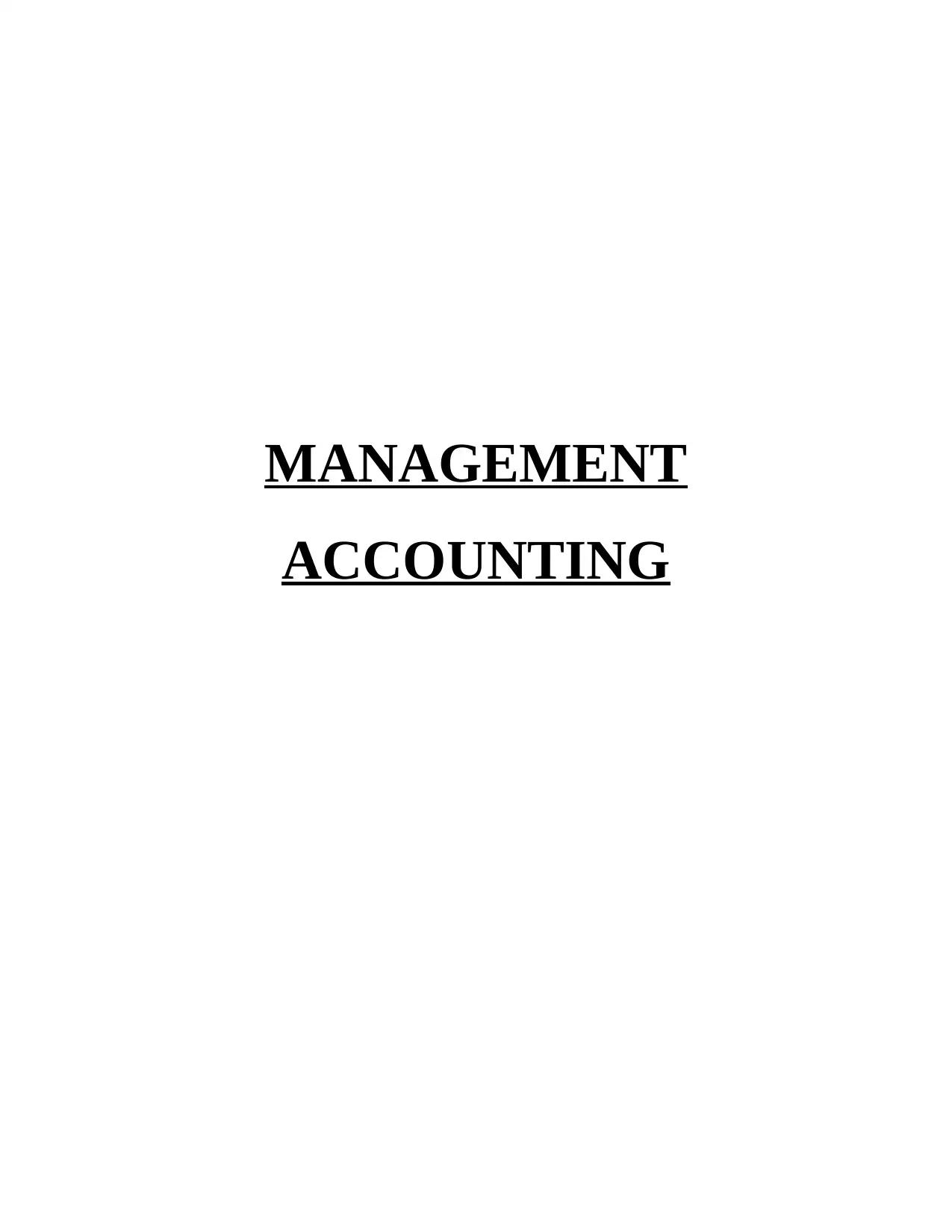
MANAGEMENT
ACCOUNTING
ACCOUNTING
Paraphrase This Document
Need a fresh take? Get an instant paraphrase of this document with our AI Paraphraser
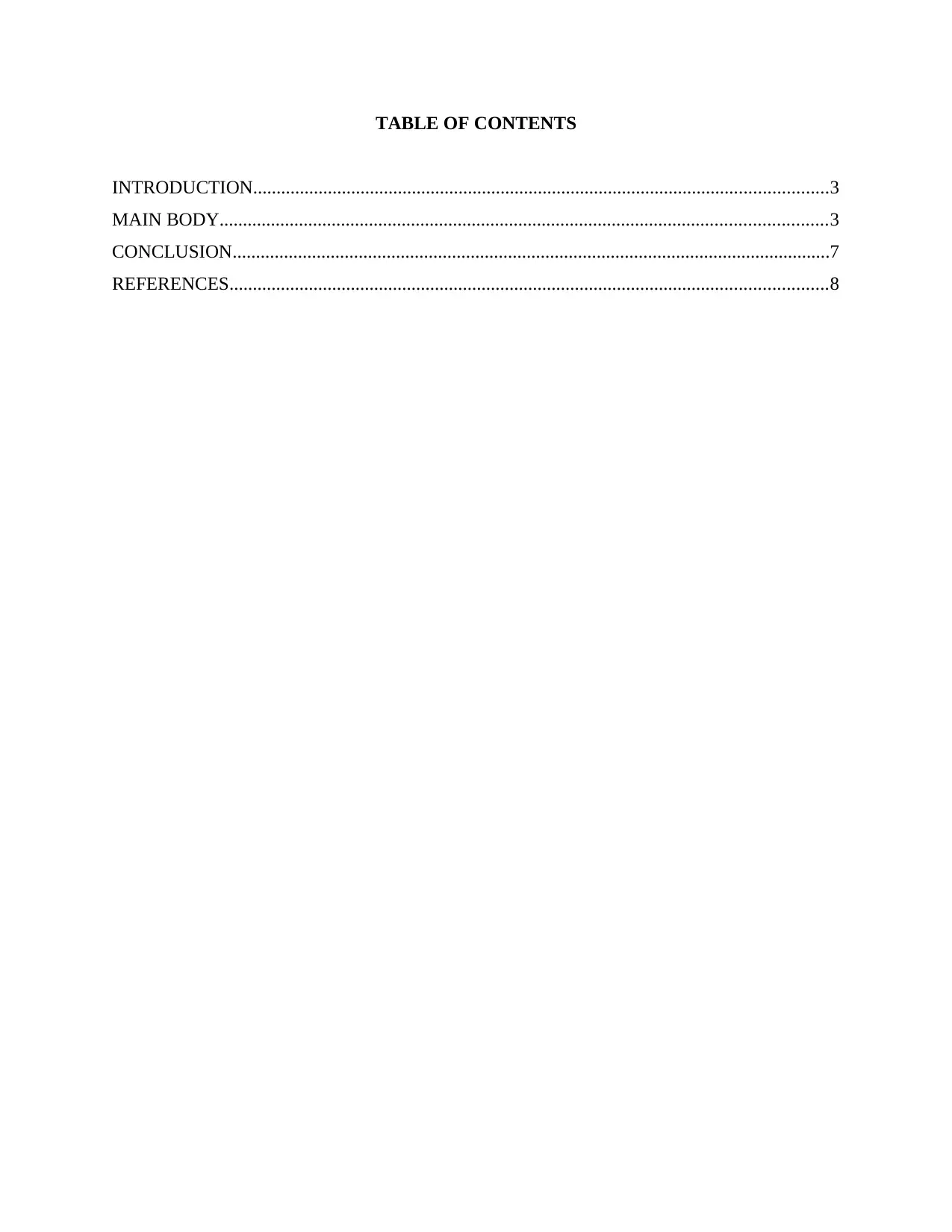
TABLE OF CONTENTS
INTRODUCTION...........................................................................................................................3
MAIN BODY..................................................................................................................................3
CONCLUSION................................................................................................................................7
REFERENCES................................................................................................................................8
INTRODUCTION...........................................................................................................................3
MAIN BODY..................................................................................................................................3
CONCLUSION................................................................................................................................7
REFERENCES................................................................................................................................8
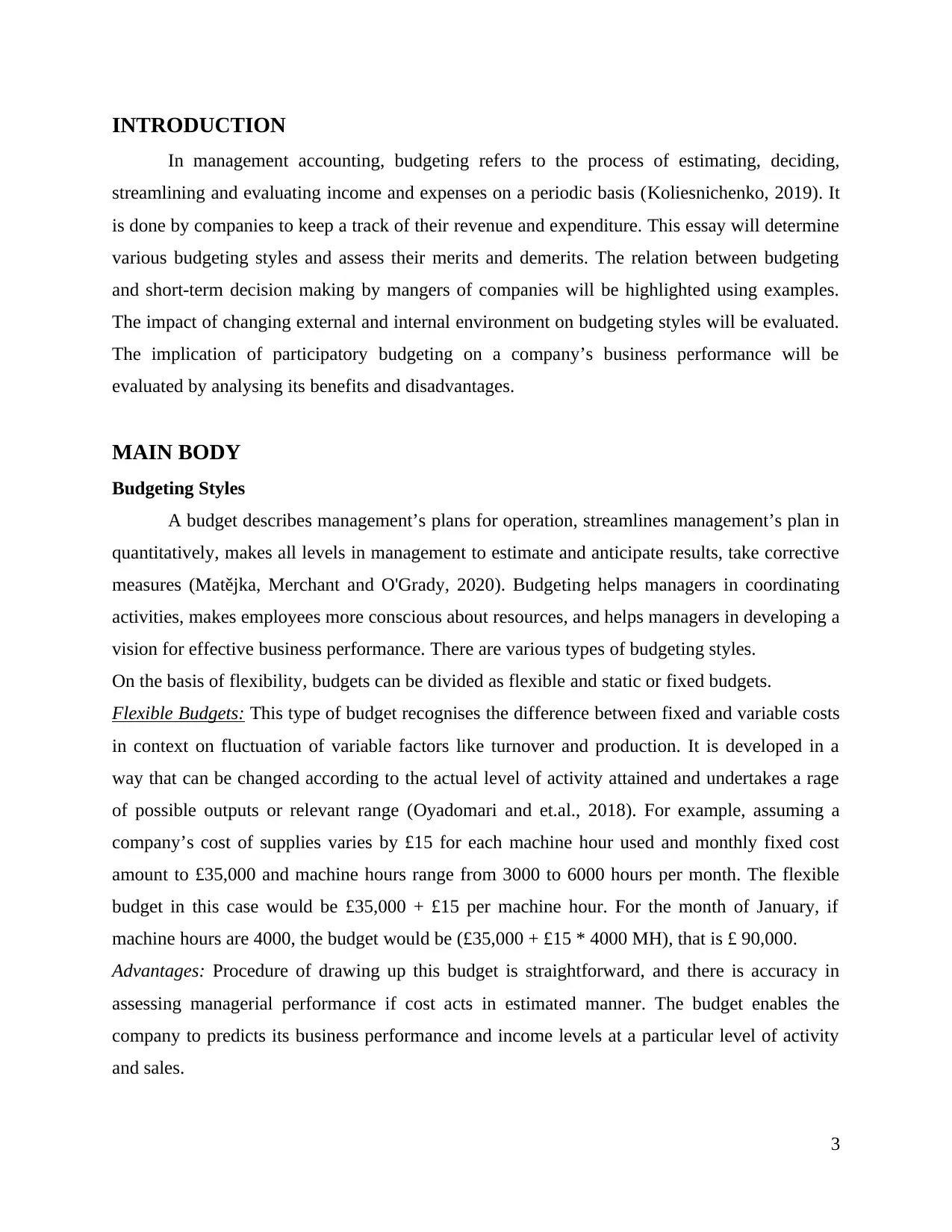
INTRODUCTION
In management accounting, budgeting refers to the process of estimating, deciding,
streamlining and evaluating income and expenses on a periodic basis (Koliesnichenko, 2019). It
is done by companies to keep a track of their revenue and expenditure. This essay will determine
various budgeting styles and assess their merits and demerits. The relation between budgeting
and short-term decision making by mangers of companies will be highlighted using examples.
The impact of changing external and internal environment on budgeting styles will be evaluated.
The implication of participatory budgeting on a company’s business performance will be
evaluated by analysing its benefits and disadvantages.
MAIN BODY
Budgeting Styles
A budget describes management’s plans for operation, streamlines management’s plan in
quantitatively, makes all levels in management to estimate and anticipate results, take corrective
measures (Matějka, Merchant and O'Grady, 2020). Budgeting helps managers in coordinating
activities, makes employees more conscious about resources, and helps managers in developing a
vision for effective business performance. There are various types of budgeting styles.
On the basis of flexibility, budgets can be divided as flexible and static or fixed budgets.
Flexible Budgets: This type of budget recognises the difference between fixed and variable costs
in context on fluctuation of variable factors like turnover and production. It is developed in a
way that can be changed according to the actual level of activity attained and undertakes a rage
of possible outputs or relevant range (Oyadomari and et.al., 2018). For example, assuming a
company’s cost of supplies varies by £15 for each machine hour used and monthly fixed cost
amount to £35,000 and machine hours range from 3000 to 6000 hours per month. The flexible
budget in this case would be £35,000 + £15 per machine hour. For the month of January, if
machine hours are 4000, the budget would be (£35,000 + £15 * 4000 MH), that is £ 90,000.
Advantages: Procedure of drawing up this budget is straightforward, and there is accuracy in
assessing managerial performance if cost acts in estimated manner. The budget enables the
company to predicts its business performance and income levels at a particular level of activity
and sales.
3
In management accounting, budgeting refers to the process of estimating, deciding,
streamlining and evaluating income and expenses on a periodic basis (Koliesnichenko, 2019). It
is done by companies to keep a track of their revenue and expenditure. This essay will determine
various budgeting styles and assess their merits and demerits. The relation between budgeting
and short-term decision making by mangers of companies will be highlighted using examples.
The impact of changing external and internal environment on budgeting styles will be evaluated.
The implication of participatory budgeting on a company’s business performance will be
evaluated by analysing its benefits and disadvantages.
MAIN BODY
Budgeting Styles
A budget describes management’s plans for operation, streamlines management’s plan in
quantitatively, makes all levels in management to estimate and anticipate results, take corrective
measures (Matějka, Merchant and O'Grady, 2020). Budgeting helps managers in coordinating
activities, makes employees more conscious about resources, and helps managers in developing a
vision for effective business performance. There are various types of budgeting styles.
On the basis of flexibility, budgets can be divided as flexible and static or fixed budgets.
Flexible Budgets: This type of budget recognises the difference between fixed and variable costs
in context on fluctuation of variable factors like turnover and production. It is developed in a
way that can be changed according to the actual level of activity attained and undertakes a rage
of possible outputs or relevant range (Oyadomari and et.al., 2018). For example, assuming a
company’s cost of supplies varies by £15 for each machine hour used and monthly fixed cost
amount to £35,000 and machine hours range from 3000 to 6000 hours per month. The flexible
budget in this case would be £35,000 + £15 per machine hour. For the month of January, if
machine hours are 4000, the budget would be (£35,000 + £15 * 4000 MH), that is £ 90,000.
Advantages: Procedure of drawing up this budget is straightforward, and there is accuracy in
assessing managerial performance if cost acts in estimated manner. The budget enables the
company to predicts its business performance and income levels at a particular level of activity
and sales.
3
⊘ This is a preview!⊘
Do you want full access?
Subscribe today to unlock all pages.

Trusted by 1+ million students worldwide
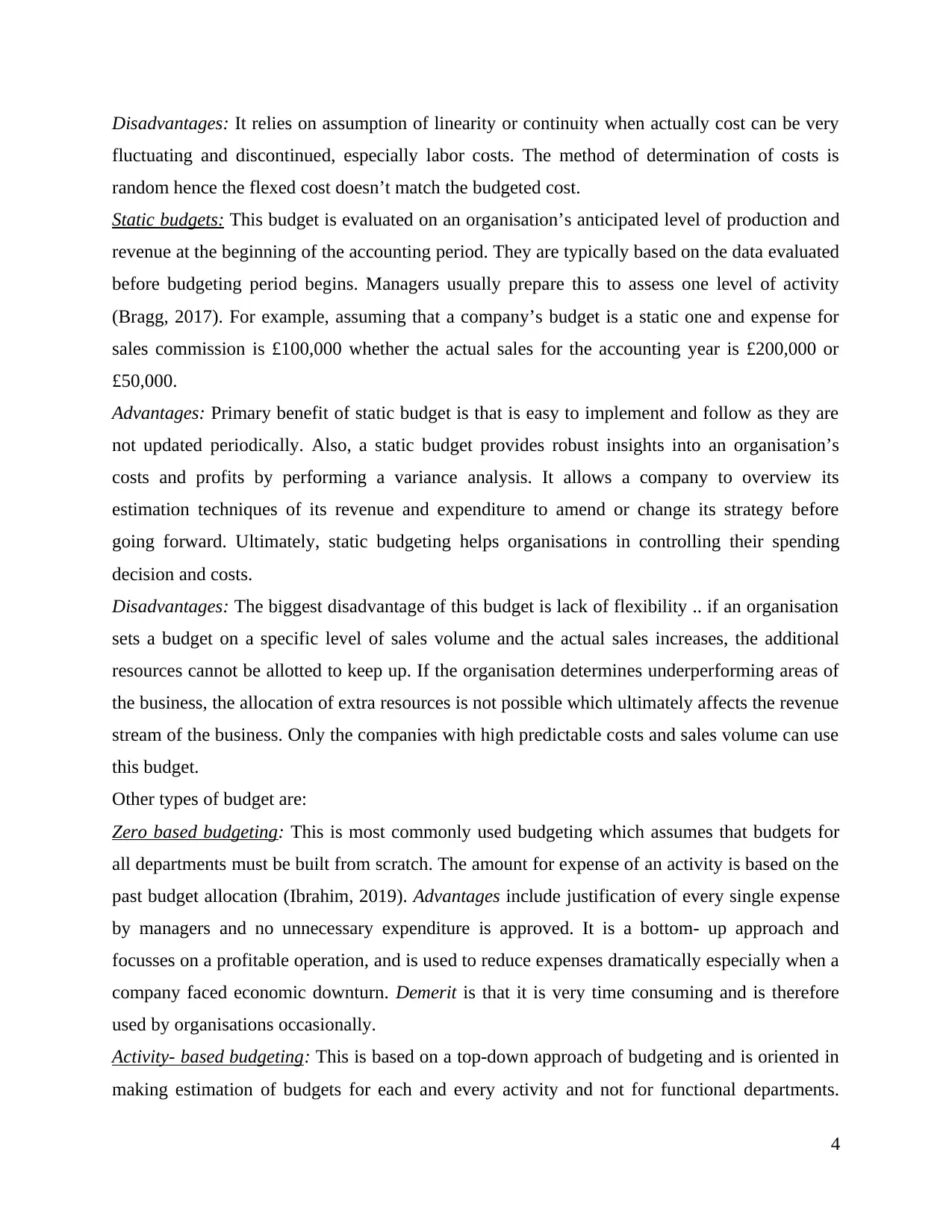
Disadvantages: It relies on assumption of linearity or continuity when actually cost can be very
fluctuating and discontinued, especially labor costs. The method of determination of costs is
random hence the flexed cost doesn’t match the budgeted cost.
Static budgets: This budget is evaluated on an organisation’s anticipated level of production and
revenue at the beginning of the accounting period. They are typically based on the data evaluated
before budgeting period begins. Managers usually prepare this to assess one level of activity
(Bragg, 2017). For example, assuming that a company’s budget is a static one and expense for
sales commission is £100,000 whether the actual sales for the accounting year is £200,000 or
£50,000.
Advantages: Primary benefit of static budget is that is easy to implement and follow as they are
not updated periodically. Also, a static budget provides robust insights into an organisation’s
costs and profits by performing a variance analysis. It allows a company to overview its
estimation techniques of its revenue and expenditure to amend or change its strategy before
going forward. Ultimately, static budgeting helps organisations in controlling their spending
decision and costs.
Disadvantages: The biggest disadvantage of this budget is lack of flexibility .. if an organisation
sets a budget on a specific level of sales volume and the actual sales increases, the additional
resources cannot be allotted to keep up. If the organisation determines underperforming areas of
the business, the allocation of extra resources is not possible which ultimately affects the revenue
stream of the business. Only the companies with high predictable costs and sales volume can use
this budget.
Other types of budget are:
Zero based budgeting: This is most commonly used budgeting which assumes that budgets for
all departments must be built from scratch. The amount for expense of an activity is based on the
past budget allocation (Ibrahim, 2019). Advantages include justification of every single expense
by managers and no unnecessary expenditure is approved. It is a bottom- up approach and
focusses on a profitable operation, and is used to reduce expenses dramatically especially when a
company faced economic downturn. Demerit is that it is very time consuming and is therefore
used by organisations occasionally.
Activity- based budgeting: This is based on a top-down approach of budgeting and is oriented in
making estimation of budgets for each and every activity and not for functional departments.
4
fluctuating and discontinued, especially labor costs. The method of determination of costs is
random hence the flexed cost doesn’t match the budgeted cost.
Static budgets: This budget is evaluated on an organisation’s anticipated level of production and
revenue at the beginning of the accounting period. They are typically based on the data evaluated
before budgeting period begins. Managers usually prepare this to assess one level of activity
(Bragg, 2017). For example, assuming that a company’s budget is a static one and expense for
sales commission is £100,000 whether the actual sales for the accounting year is £200,000 or
£50,000.
Advantages: Primary benefit of static budget is that is easy to implement and follow as they are
not updated periodically. Also, a static budget provides robust insights into an organisation’s
costs and profits by performing a variance analysis. It allows a company to overview its
estimation techniques of its revenue and expenditure to amend or change its strategy before
going forward. Ultimately, static budgeting helps organisations in controlling their spending
decision and costs.
Disadvantages: The biggest disadvantage of this budget is lack of flexibility .. if an organisation
sets a budget on a specific level of sales volume and the actual sales increases, the additional
resources cannot be allotted to keep up. If the organisation determines underperforming areas of
the business, the allocation of extra resources is not possible which ultimately affects the revenue
stream of the business. Only the companies with high predictable costs and sales volume can use
this budget.
Other types of budget are:
Zero based budgeting: This is most commonly used budgeting which assumes that budgets for
all departments must be built from scratch. The amount for expense of an activity is based on the
past budget allocation (Ibrahim, 2019). Advantages include justification of every single expense
by managers and no unnecessary expenditure is approved. It is a bottom- up approach and
focusses on a profitable operation, and is used to reduce expenses dramatically especially when a
company faced economic downturn. Demerit is that it is very time consuming and is therefore
used by organisations occasionally.
Activity- based budgeting: This is based on a top-down approach of budgeting and is oriented in
making estimation of budgets for each and every activity and not for functional departments.
4
Paraphrase This Document
Need a fresh take? Get an instant paraphrase of this document with our AI Paraphraser
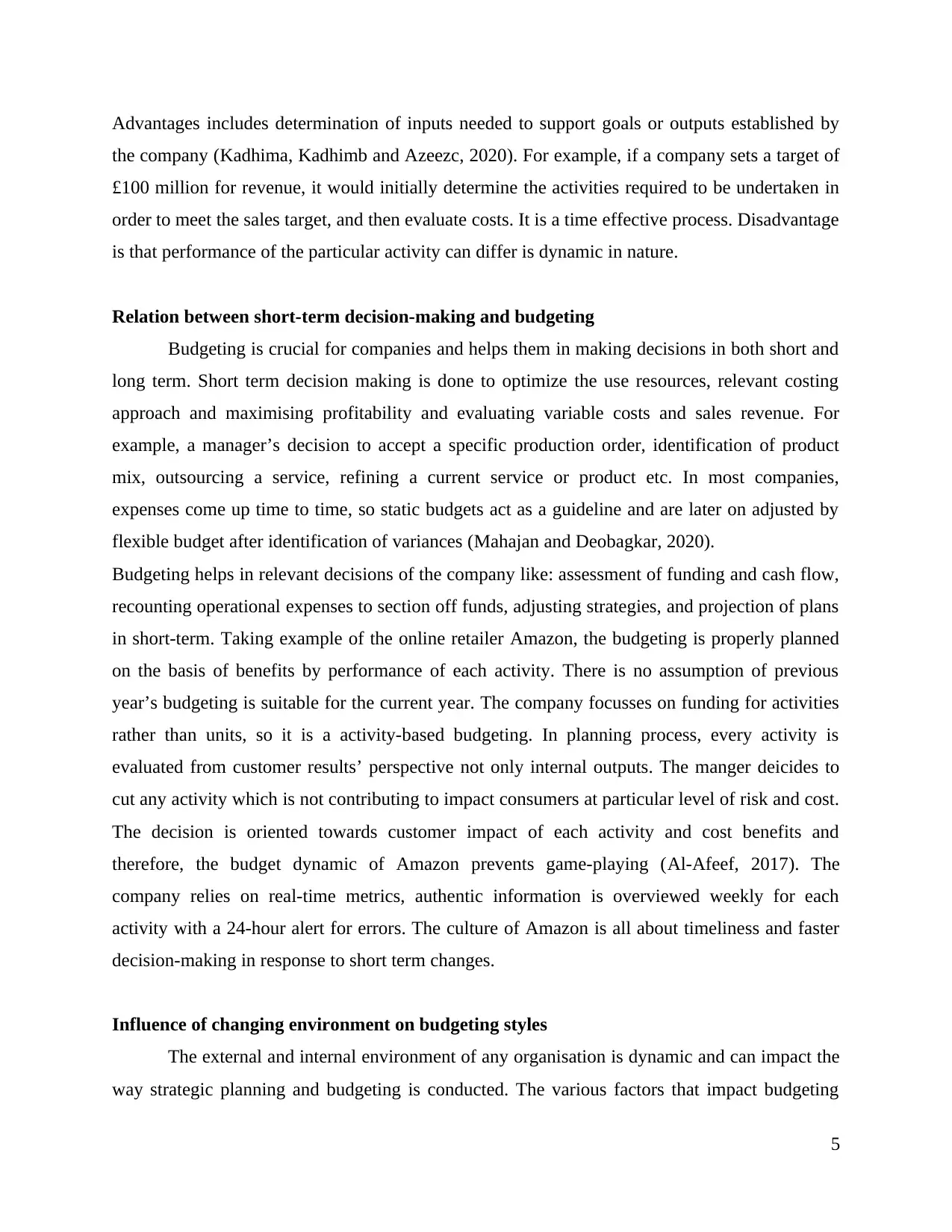
Advantages includes determination of inputs needed to support goals or outputs established by
the company (Kadhima, Kadhimb and Azeezc, 2020). For example, if a company sets a target of
£100 million for revenue, it would initially determine the activities required to be undertaken in
order to meet the sales target, and then evaluate costs. It is a time effective process. Disadvantage
is that performance of the particular activity can differ is dynamic in nature.
Relation between short-term decision-making and budgeting
Budgeting is crucial for companies and helps them in making decisions in both short and
long term. Short term decision making is done to optimize the use resources, relevant costing
approach and maximising profitability and evaluating variable costs and sales revenue. For
example, a manager’s decision to accept a specific production order, identification of product
mix, outsourcing a service, refining a current service or product etc. In most companies,
expenses come up time to time, so static budgets act as a guideline and are later on adjusted by
flexible budget after identification of variances (Mahajan and Deobagkar, 2020).
Budgeting helps in relevant decisions of the company like: assessment of funding and cash flow,
recounting operational expenses to section off funds, adjusting strategies, and projection of plans
in short-term. Taking example of the online retailer Amazon, the budgeting is properly planned
on the basis of benefits by performance of each activity. There is no assumption of previous
year’s budgeting is suitable for the current year. The company focusses on funding for activities
rather than units, so it is a activity-based budgeting. In planning process, every activity is
evaluated from customer results’ perspective not only internal outputs. The manger deicides to
cut any activity which is not contributing to impact consumers at particular level of risk and cost.
The decision is oriented towards customer impact of each activity and cost benefits and
therefore, the budget dynamic of Amazon prevents game-playing (Al-Afeef, 2017). The
company relies on real-time metrics, authentic information is overviewed weekly for each
activity with a 24-hour alert for errors. The culture of Amazon is all about timeliness and faster
decision-making in response to short term changes.
Influence of changing environment on budgeting styles
The external and internal environment of any organisation is dynamic and can impact the
way strategic planning and budgeting is conducted. The various factors that impact budgeting
5
the company (Kadhima, Kadhimb and Azeezc, 2020). For example, if a company sets a target of
£100 million for revenue, it would initially determine the activities required to be undertaken in
order to meet the sales target, and then evaluate costs. It is a time effective process. Disadvantage
is that performance of the particular activity can differ is dynamic in nature.
Relation between short-term decision-making and budgeting
Budgeting is crucial for companies and helps them in making decisions in both short and
long term. Short term decision making is done to optimize the use resources, relevant costing
approach and maximising profitability and evaluating variable costs and sales revenue. For
example, a manager’s decision to accept a specific production order, identification of product
mix, outsourcing a service, refining a current service or product etc. In most companies,
expenses come up time to time, so static budgets act as a guideline and are later on adjusted by
flexible budget after identification of variances (Mahajan and Deobagkar, 2020).
Budgeting helps in relevant decisions of the company like: assessment of funding and cash flow,
recounting operational expenses to section off funds, adjusting strategies, and projection of plans
in short-term. Taking example of the online retailer Amazon, the budgeting is properly planned
on the basis of benefits by performance of each activity. There is no assumption of previous
year’s budgeting is suitable for the current year. The company focusses on funding for activities
rather than units, so it is a activity-based budgeting. In planning process, every activity is
evaluated from customer results’ perspective not only internal outputs. The manger deicides to
cut any activity which is not contributing to impact consumers at particular level of risk and cost.
The decision is oriented towards customer impact of each activity and cost benefits and
therefore, the budget dynamic of Amazon prevents game-playing (Al-Afeef, 2017). The
company relies on real-time metrics, authentic information is overviewed weekly for each
activity with a 24-hour alert for errors. The culture of Amazon is all about timeliness and faster
decision-making in response to short term changes.
Influence of changing environment on budgeting styles
The external and internal environment of any organisation is dynamic and can impact the
way strategic planning and budgeting is conducted. The various factors that impact budgeting
5
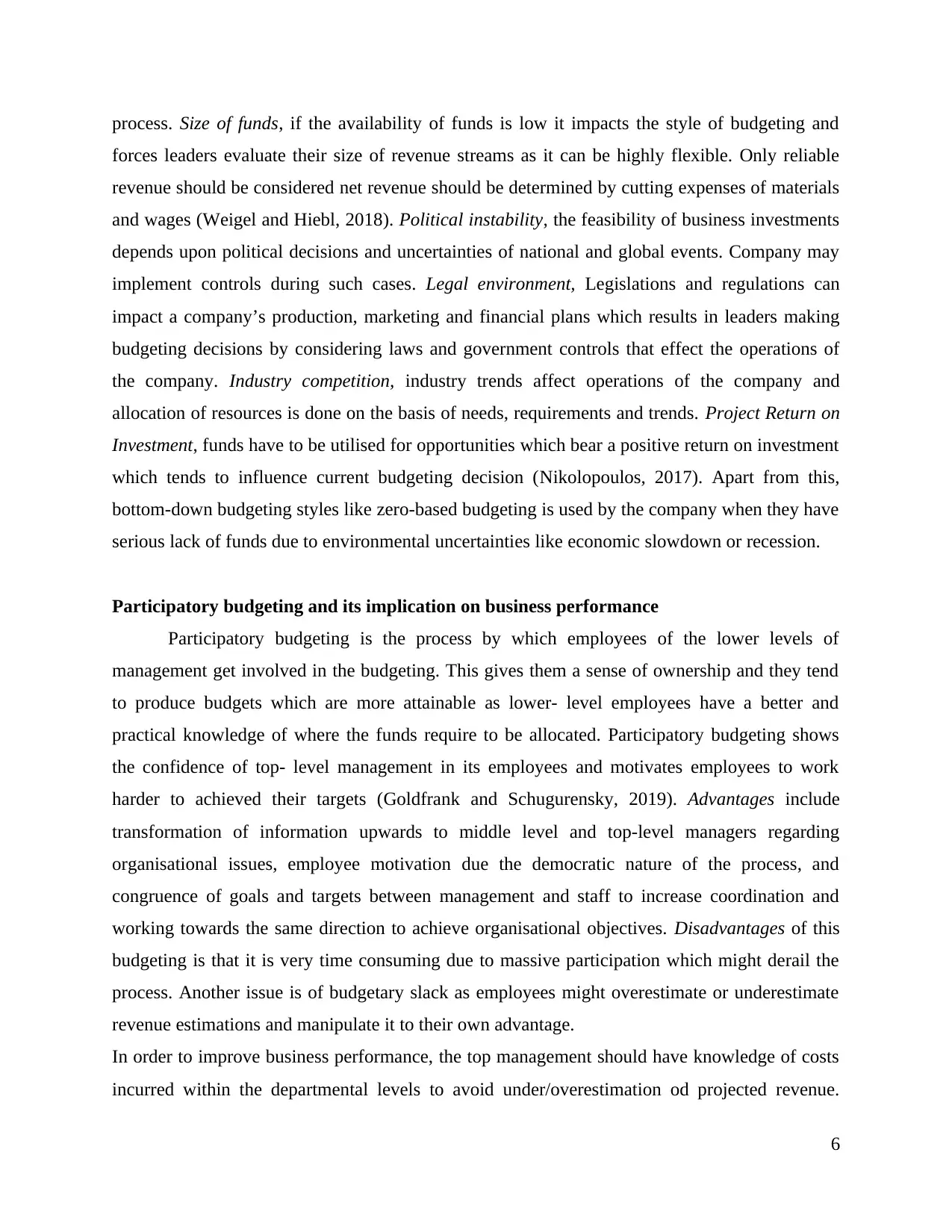
process. Size of funds, if the availability of funds is low it impacts the style of budgeting and
forces leaders evaluate their size of revenue streams as it can be highly flexible. Only reliable
revenue should be considered net revenue should be determined by cutting expenses of materials
and wages (Weigel and Hiebl, 2018). Political instability, the feasibility of business investments
depends upon political decisions and uncertainties of national and global events. Company may
implement controls during such cases. Legal environment, Legislations and regulations can
impact a company’s production, marketing and financial plans which results in leaders making
budgeting decisions by considering laws and government controls that effect the operations of
the company. Industry competition, industry trends affect operations of the company and
allocation of resources is done on the basis of needs, requirements and trends. Project Return on
Investment, funds have to be utilised for opportunities which bear a positive return on investment
which tends to influence current budgeting decision (Nikolopoulos, 2017). Apart from this,
bottom-down budgeting styles like zero-based budgeting is used by the company when they have
serious lack of funds due to environmental uncertainties like economic slowdown or recession.
Participatory budgeting and its implication on business performance
Participatory budgeting is the process by which employees of the lower levels of
management get involved in the budgeting. This gives them a sense of ownership and they tend
to produce budgets which are more attainable as lower- level employees have a better and
practical knowledge of where the funds require to be allocated. Participatory budgeting shows
the confidence of top- level management in its employees and motivates employees to work
harder to achieved their targets (Goldfrank and Schugurensky, 2019). Advantages include
transformation of information upwards to middle level and top-level managers regarding
organisational issues, employee motivation due the democratic nature of the process, and
congruence of goals and targets between management and staff to increase coordination and
working towards the same direction to achieve organisational objectives. Disadvantages of this
budgeting is that it is very time consuming due to massive participation which might derail the
process. Another issue is of budgetary slack as employees might overestimate or underestimate
revenue estimations and manipulate it to their own advantage.
In order to improve business performance, the top management should have knowledge of costs
incurred within the departmental levels to avoid under/overestimation od projected revenue.
6
forces leaders evaluate their size of revenue streams as it can be highly flexible. Only reliable
revenue should be considered net revenue should be determined by cutting expenses of materials
and wages (Weigel and Hiebl, 2018). Political instability, the feasibility of business investments
depends upon political decisions and uncertainties of national and global events. Company may
implement controls during such cases. Legal environment, Legislations and regulations can
impact a company’s production, marketing and financial plans which results in leaders making
budgeting decisions by considering laws and government controls that effect the operations of
the company. Industry competition, industry trends affect operations of the company and
allocation of resources is done on the basis of needs, requirements and trends. Project Return on
Investment, funds have to be utilised for opportunities which bear a positive return on investment
which tends to influence current budgeting decision (Nikolopoulos, 2017). Apart from this,
bottom-down budgeting styles like zero-based budgeting is used by the company when they have
serious lack of funds due to environmental uncertainties like economic slowdown or recession.
Participatory budgeting and its implication on business performance
Participatory budgeting is the process by which employees of the lower levels of
management get involved in the budgeting. This gives them a sense of ownership and they tend
to produce budgets which are more attainable as lower- level employees have a better and
practical knowledge of where the funds require to be allocated. Participatory budgeting shows
the confidence of top- level management in its employees and motivates employees to work
harder to achieved their targets (Goldfrank and Schugurensky, 2019). Advantages include
transformation of information upwards to middle level and top-level managers regarding
organisational issues, employee motivation due the democratic nature of the process, and
congruence of goals and targets between management and staff to increase coordination and
working towards the same direction to achieve organisational objectives. Disadvantages of this
budgeting is that it is very time consuming due to massive participation which might derail the
process. Another issue is of budgetary slack as employees might overestimate or underestimate
revenue estimations and manipulate it to their own advantage.
In order to improve business performance, the top management should have knowledge of costs
incurred within the departmental levels to avoid under/overestimation od projected revenue.
6
⊘ This is a preview!⊘
Do you want full access?
Subscribe today to unlock all pages.

Trusted by 1+ million students worldwide
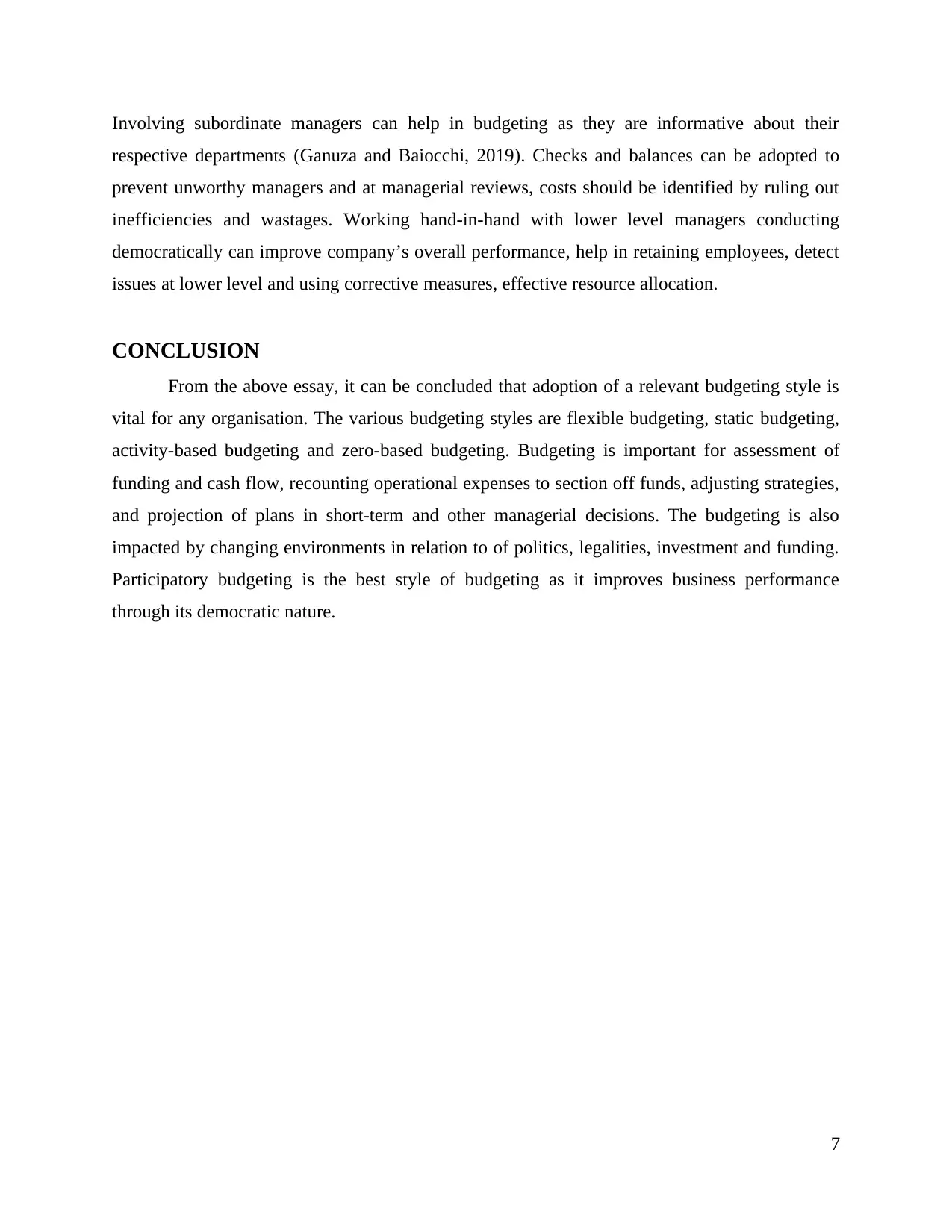
Involving subordinate managers can help in budgeting as they are informative about their
respective departments (Ganuza and Baiocchi, 2019). Checks and balances can be adopted to
prevent unworthy managers and at managerial reviews, costs should be identified by ruling out
inefficiencies and wastages. Working hand-in-hand with lower level managers conducting
democratically can improve company’s overall performance, help in retaining employees, detect
issues at lower level and using corrective measures, effective resource allocation.
CONCLUSION
From the above essay, it can be concluded that adoption of a relevant budgeting style is
vital for any organisation. The various budgeting styles are flexible budgeting, static budgeting,
activity-based budgeting and zero-based budgeting. Budgeting is important for assessment of
funding and cash flow, recounting operational expenses to section off funds, adjusting strategies,
and projection of plans in short-term and other managerial decisions. The budgeting is also
impacted by changing environments in relation to of politics, legalities, investment and funding.
Participatory budgeting is the best style of budgeting as it improves business performance
through its democratic nature.
7
respective departments (Ganuza and Baiocchi, 2019). Checks and balances can be adopted to
prevent unworthy managers and at managerial reviews, costs should be identified by ruling out
inefficiencies and wastages. Working hand-in-hand with lower level managers conducting
democratically can improve company’s overall performance, help in retaining employees, detect
issues at lower level and using corrective measures, effective resource allocation.
CONCLUSION
From the above essay, it can be concluded that adoption of a relevant budgeting style is
vital for any organisation. The various budgeting styles are flexible budgeting, static budgeting,
activity-based budgeting and zero-based budgeting. Budgeting is important for assessment of
funding and cash flow, recounting operational expenses to section off funds, adjusting strategies,
and projection of plans in short-term and other managerial decisions. The budgeting is also
impacted by changing environments in relation to of politics, legalities, investment and funding.
Participatory budgeting is the best style of budgeting as it improves business performance
through its democratic nature.
7
Paraphrase This Document
Need a fresh take? Get an instant paraphrase of this document with our AI Paraphraser
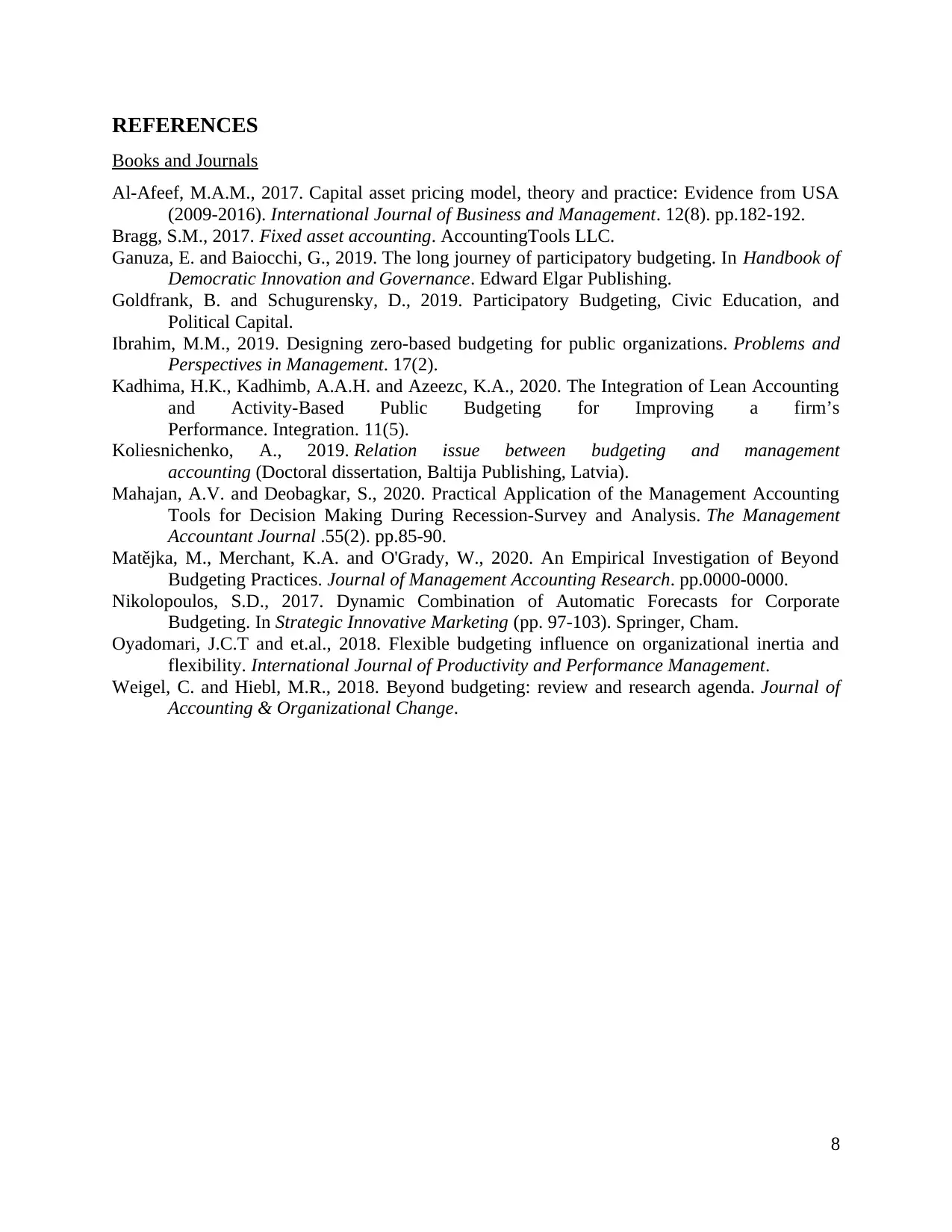
REFERENCES
Books and Journals
Al-Afeef, M.A.M., 2017. Capital asset pricing model, theory and practice: Evidence from USA
(2009-2016). International Journal of Business and Management. 12(8). pp.182-192.
Bragg, S.M., 2017. Fixed asset accounting. AccountingTools LLC.
Ganuza, E. and Baiocchi, G., 2019. The long journey of participatory budgeting. In Handbook of
Democratic Innovation and Governance. Edward Elgar Publishing.
Goldfrank, B. and Schugurensky, D., 2019. Participatory Budgeting, Civic Education, and
Political Capital.
Ibrahim, M.M., 2019. Designing zero-based budgeting for public organizations. Problems and
Perspectives in Management. 17(2).
Kadhima, H.K., Kadhimb, A.A.H. and Azeezc, K.A., 2020. The Integration of Lean Accounting
and Activity-Based Public Budgeting for Improving a firm’s
Performance. Integration. 11(5).
Koliesnichenko, A., 2019. Relation issue between budgeting and management
accounting (Doctoral dissertation, Baltija Publishing, Latvia).
Mahajan, A.V. and Deobagkar, S., 2020. Practical Application of the Management Accounting
Tools for Decision Making During Recession-Survey and Analysis. The Management
Accountant Journal .55(2). pp.85-90.
Matějka, M., Merchant, K.A. and O'Grady, W., 2020. An Empirical Investigation of Beyond
Budgeting Practices. Journal of Management Accounting Research. pp.0000-0000.
Nikolopoulos, S.D., 2017. Dynamic Combination of Automatic Forecasts for Corporate
Budgeting. In Strategic Innovative Marketing (pp. 97-103). Springer, Cham.
Oyadomari, J.C.T and et.al., 2018. Flexible budgeting influence on organizational inertia and
flexibility. International Journal of Productivity and Performance Management.
Weigel, C. and Hiebl, M.R., 2018. Beyond budgeting: review and research agenda. Journal of
Accounting & Organizational Change.
8
Books and Journals
Al-Afeef, M.A.M., 2017. Capital asset pricing model, theory and practice: Evidence from USA
(2009-2016). International Journal of Business and Management. 12(8). pp.182-192.
Bragg, S.M., 2017. Fixed asset accounting. AccountingTools LLC.
Ganuza, E. and Baiocchi, G., 2019. The long journey of participatory budgeting. In Handbook of
Democratic Innovation and Governance. Edward Elgar Publishing.
Goldfrank, B. and Schugurensky, D., 2019. Participatory Budgeting, Civic Education, and
Political Capital.
Ibrahim, M.M., 2019. Designing zero-based budgeting for public organizations. Problems and
Perspectives in Management. 17(2).
Kadhima, H.K., Kadhimb, A.A.H. and Azeezc, K.A., 2020. The Integration of Lean Accounting
and Activity-Based Public Budgeting for Improving a firm’s
Performance. Integration. 11(5).
Koliesnichenko, A., 2019. Relation issue between budgeting and management
accounting (Doctoral dissertation, Baltija Publishing, Latvia).
Mahajan, A.V. and Deobagkar, S., 2020. Practical Application of the Management Accounting
Tools for Decision Making During Recession-Survey and Analysis. The Management
Accountant Journal .55(2). pp.85-90.
Matějka, M., Merchant, K.A. and O'Grady, W., 2020. An Empirical Investigation of Beyond
Budgeting Practices. Journal of Management Accounting Research. pp.0000-0000.
Nikolopoulos, S.D., 2017. Dynamic Combination of Automatic Forecasts for Corporate
Budgeting. In Strategic Innovative Marketing (pp. 97-103). Springer, Cham.
Oyadomari, J.C.T and et.al., 2018. Flexible budgeting influence on organizational inertia and
flexibility. International Journal of Productivity and Performance Management.
Weigel, C. and Hiebl, M.R., 2018. Beyond budgeting: review and research agenda. Journal of
Accounting & Organizational Change.
8
1 out of 8
Related Documents
Your All-in-One AI-Powered Toolkit for Academic Success.
+13062052269
info@desklib.com
Available 24*7 on WhatsApp / Email
![[object Object]](/_next/static/media/star-bottom.7253800d.svg)
Unlock your academic potential
Copyright © 2020–2025 A2Z Services. All Rights Reserved. Developed and managed by ZUCOL.





